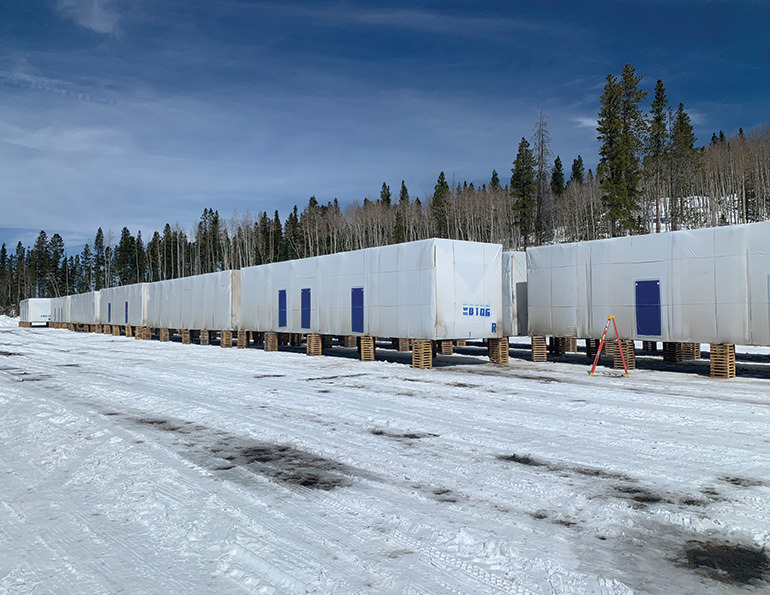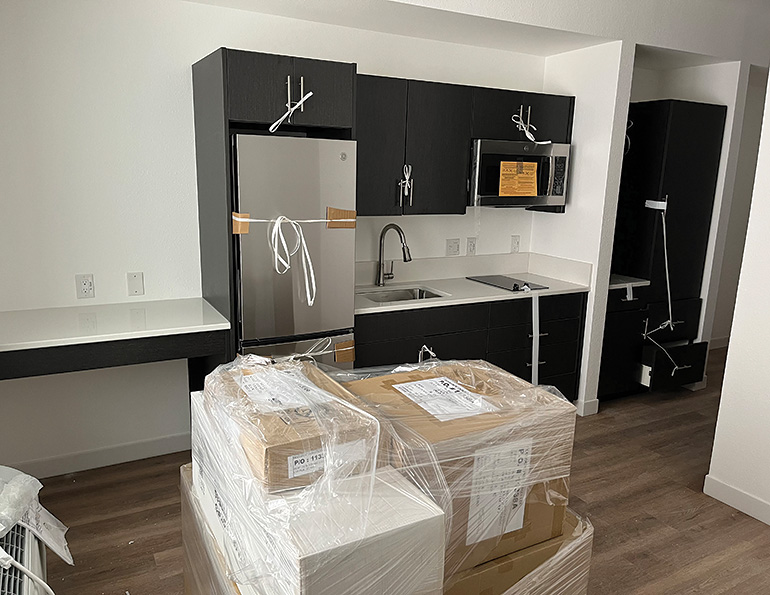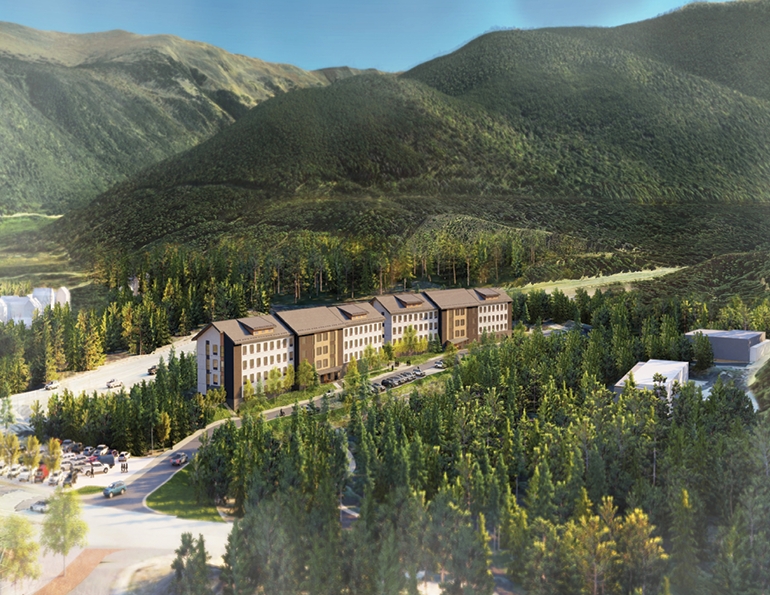Climate change is a generational challenge for the winter sports industry, but ask Alterra Mountain Company chief development officer Bryan Elliott about his biggest headache, and it’s something far more prosaic: where ski area employees are going to lay their heads at night.
“Housing is number-one from my perspective,” says Elliott, whose company is investing roughly $350 million over the next five years, including a $50 million allotment for fiscal year 2024, to build and acquire affordable housing for some of the company’s 24,000 employees.
“If you don’t have a place [for people] to live, then you don’t have people to run your lifts or work in your hotels, and you don’t have a business,” says Elliott. “We recognize this as a super priority and are not just addressing it as a short-term problem.”
Over five years, Alterra aims to nearly double its employee housing capacity, starting with adding almost 500 beds at Palisades Tahoe, Calif., Stratton, Vt., Tremblant in Quebec, and Winter Park, Colo. The latter will open a new “premier housing facility” that will home more than 300 employees on resort grounds, according to Alterra. In the next phase, the company will add approximately 1,000 more affordable workforce housing beds at Ontario’s Blue Mountain, Crystal Mountain, Wash., Sugarbush, Vt., and Deer Valley Resort in Utah.
Alterra currently leases or owns approximately 4,000 beds for employees, with a target to deliver about 3,000 more—including the 1,500 outlined above—in the coming years.
Elliott says that about 60 percent of the new housing will be built by the company, with the rest consisting of acquisitions of existing rooms and properties. “We prefer to develop, but that takes longer,” he notes.
WIDESPREAD PROBLEM
The challenge of meeting employee housing needs may be more acute at some Alterra resorts than others, but it’s a problem that’s common at all of the company’s 16 properties and, indeed, across ski country in general. In the 2021-22 ski season, for example, the National Ski Areas Association (NSAA) reported record visitation of roughly 61 million skier visits in its Kottke End of Season and Demographic Report, but 81 percent of responding ski areas said they were not fully staffed, with an average of 75 positions left unfilled—a challenging juxtaposition.
“Ski areas responded by raising wages, adding end-of-season bonuses, and investing in affordable workforce housing,” the report said.
Exacerbated crisis. Still, bonuses and a bumped-up industry standard for minimum wage (to as high as $20 at Vail Resorts, for example) falls far short of the income that employees need to make rent in ski towns. Lake Tahoe, home of Palisades Tahoe, for example, has a median home sales price of close to $1 million, according to Redfin, and Rent Cafe pegs the average rent for an apartment in South Lake Tahoe at more than $2,000 per month.
Finding housing for workers has long been a challenge in communities like Lake Tahoe and Park City, but the pandemic took the situation from a “quasi-crisis to a real crisis,” says Elliott.
“People started renting out their properties [for higher prices] or selling them to take gains to buyers who were going to use them,” he says. “Where previously employees could find a place, and we could help make it affordable, that was no longer an option. People were accepting jobs with us, but couldn’t find places to live and ended up not taking positions.”
BUILDING VS. ACQUIRING
Even when Alterra could find housing it could help subsidize, rising costs began to make the idea of building rather than renting more attractive, says Elliott. “It made building properties equally economical, and we [could] control our own destiny” rather than being at the whim of landlords who could decide to sell or take their property out of the rental pool, he says.
In Lake Tahoe—which Elliott says is the company’s most challenging housing market—that’s exactly what happened at the beginning of the current season, when the owner of a hotel where Alterra was leasing decided to retire and sell. “The 80 beds we had last season went away,” he says, leading Alterra to look as far away as Reno—about an hour’s drive away—in a frantic search for housing.
Cutting through red tape. Of course, building new housing carries challenges of its own. First, “We’re operators, not developers,” says Elliott. Second, there’s the usual gauntlet of zoning, public hearings, and permitting to run through in any community, but that can be especially difficult in upscale resort towns, where development land is scarce and pressure from current property owners can be formidable.
For both practical and political reasons, Alterra has sought to develop or acquire properties located in urban areas rather than suburbs or rural areas, the latter of which also may lack basic utility services like power and water. In Park City, for example, the company has acquired a parcel of land that formerly was home to a laundromat and gas station.
“We prefer that, because it has access to transit, groceries, and other services,” says Elliott. “Building closer to residential areas pushes people’s patience, and if it’s too remote, the cost to service it properly becomes prohibitive.”
“Hospitality conversions”—turning a former motel or hotel into employee housing—has long been part of the housing mix for Alterra, as it has been for other ski areas. These projects typically include installing kitchens in former hotel rooms—interestingly, older hotels tend to be better candidates because the rooms are often larger—and converting public spaces into communal living areas. Elliott notes that compliance with ADA requirements can be a hurdle when trying to convert older properties.
In cases where it’s practical, Alterra has chosen to build housing on its own property, although that’s not always a perfect or easy solution. “Who wants to live in the parking lot of the place they work?” asks Elliott, though it’s certainly one solution.
MASTER PLANNING
The master plan for Palisades Tahoe includes a provision for new employee housing, but legal challenges have held up that and other development for the last seven years. Housing is also in Alterra’s master plans for Mammoth Mountain and Winter Park, says Elliott.
Privacy, security, amenities. The 330-room Winter Park project, sited on the eastern end of the resort property, utilizes modular construction to reduce build time—units were being built in Idaho even as the resort was buried under heavy snowfall this winter. A new design concept for the units offers more privacy than a typical dorm-style building for seasonal employees.
 Modules for new housing arrive at Winter Park after being built in Idaho over the winter.
Modules for new housing arrive at Winter Park after being built in Idaho over the winter.
“Every bed has a door, which should be an industry standard,” Elliott says. Configurations include one- and two-bedroom studios with shared kitchen and bathroom facilities and key-card entry for added security. Privacy, security, and amenities like Wi-Fi and fitness centers help make the housing—and by extension, the resort—more attractive to prospective workers.
The resort will create up to four new jobs to manage the facility.
The Winter Park complex will open this year, and plans are already in the works to replicate the concept at two other Alterra resorts. But it’s not only entry-level workers or employees coming into the country on student or guest worker visas who need places to live: The housing shortage, says Elliott, also has hampered Alterra’s ability to recruit and train middle managers.
 One- and two-bedroom studios at Winter Park’s new housing site include full kitchens, bathrooms, and a host of amenities.
One- and two-bedroom studios at Winter Park’s new housing site include full kitchens, bathrooms, and a host of amenities.
The company has responded by offering down-payment assistance, but is also looking at acquiring duplex or townhome-style properties that would be more suitable to young professionals—some with families in tow—than more typical dormitory-style accommodations. “You have to very careful about mixing families with single, young, seasonal workers,” Elliott says.
Pluses and minuses. On-property housing has its pluses and minuses—easy commuting, but limited access to affordable shopping, for example—but there are also limitations on how far away employees can reasonably be housed. Alterra is currently housing some Mammoth workers in Bishop, Calif., for example—a 30-minute drive in the best conditions and a far worse commute (with steep grade climbs and tire-chain requirements) when bad weather moves in.
“We’re trying to build housing into the Mammoth master plan because we’d like not to be shuttling people from Bishop,” says Elliott.
GETTING CREATIVE
Creativity also counts. At Deer Valley, for example, Alterra partnered with the operators of a local campground to build a series of cabins that the company uses to house workers during the winter, when the campground is closed. In return, the owners get to rent the cabins out to guests during the summer.
“We’re trying everything,” says Elliott, who notes that some employees of the classic “ski bum” variety actually prefer sleeping in their own campers to residing in employee housing. “That’s why I really like the campground idea,” he says. “Cabins and pull-in sites, I think we can really make that work.”
MONEY WELL SPENT
Even if Alterra’s ambitious plan is fully realized by 2027, it won’t completely eliminate the chronic problem of housing for entry-level and even middle management employees in ski country. But it will be a significant step toward improving employee recruitment, retention, and satisfaction, says Elliott.
“The ability to fully staff our resorts is critical, and housing is a key component,” he says. “We believe investing in our people is one of the best investments we can make.”






